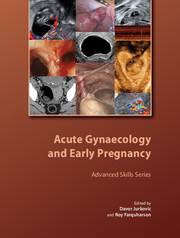Book contents
- Frontmatter
- Contents
- About the authors
- Acknowledgements
- Abbreviations
- Preface
- 1 Organisation and delivery of emergency care in early pregnancy and acute gynaecology
- 2 Epidemiology and aetiology of miscarriage and ectopic pregnancy
- 3 Diagnosis of miscarriage
- 4 Conservative and surgical management of miscarriage
- 5 Management of hyperemesis gravidarum
- 6 Diagnosis and treatment of recurrent miscarriage
- 7 Differential diagnosis and management of molar pregnancy
- 8 Drugs in early pregnancy
- 9 Diagnosis of tubal ectopic pregnancy
- 10 Conservative management of tubal ectopic pregnancy
- 11 Surgical management of tubal ectopic pregnancy
- 12 Diagnosis and management of non-tubal ectopic pregnancy
- 13 Diagnosis and management of acute pelvic pain
- 14 Management of vaginal bleeding in the acute clinical setting
- 15 Current concepts in screening and outpatient management of pelvic inflammatory disease
- 16 Diagnosis and management of haemorrhagic and septic shock
- 17 Role of minimally invasive surgery in acute gynaecology
- Index
8 - Drugs in early pregnancy
Published online by Cambridge University Press: 05 July 2014
- Frontmatter
- Contents
- About the authors
- Acknowledgements
- Abbreviations
- Preface
- 1 Organisation and delivery of emergency care in early pregnancy and acute gynaecology
- 2 Epidemiology and aetiology of miscarriage and ectopic pregnancy
- 3 Diagnosis of miscarriage
- 4 Conservative and surgical management of miscarriage
- 5 Management of hyperemesis gravidarum
- 6 Diagnosis and treatment of recurrent miscarriage
- 7 Differential diagnosis and management of molar pregnancy
- 8 Drugs in early pregnancy
- 9 Diagnosis of tubal ectopic pregnancy
- 10 Conservative management of tubal ectopic pregnancy
- 11 Surgical management of tubal ectopic pregnancy
- 12 Diagnosis and management of non-tubal ectopic pregnancy
- 13 Diagnosis and management of acute pelvic pain
- 14 Management of vaginal bleeding in the acute clinical setting
- 15 Current concepts in screening and outpatient management of pelvic inflammatory disease
- 16 Diagnosis and management of haemorrhagic and septic shock
- 17 Role of minimally invasive surgery in acute gynaecology
- Index
Summary
Introduction
Although most women are screened in the community and referred to highrisk consultant-led antenatal clinics if required, clinicians are faced with early pregnancy drug-exposure dilemmas when managing acute gynaecology emergencies. This chapter provides evidence-based knowledge regarding drug exposure in early pregnancy and help in improving the care of women in the emergency gynaecology setting (Box 8.1).
Pregnant women on average take between one and four medications during pregnancy, not including vitamins or minerals. About 80% of women use some form of medication during the first trimester of pregnancy. Nearly 70% of these are over-the-counter medications and 30% are prescriptions.
Before prescribing medicines or over-the-counter drugs to pregnant women, it is important to understand the physiological changes during pregnancy that have a marked impact on the pharmacokinetics and placental transfer of drugs. Increased cardiovascular output and expansion of plasma volume reduce drug concentrations and the drug-binding capacity of the circulating proteins. Other changes include increased renal and endocrine function, reduced lung capacity and gastrointestinal motility and changes in liver metabolism. Finally, as the placenta is primarily a lipid barrier, many of the administered drugs cross the placenta by passive diffusion and reach the fetus. Low-molecular-weight, lipid-soluble, non-ionised drugs cross the placenta more readily. The effects of drug exposure during early pregnancy depend on the developmental stage of the embryo or fetus. There are three main stages in the development of the conceptus:
• Predifferentiation or pre-embryonic stage (from conception until 17 days postconception).
- Type
- Chapter
- Information
- Acute Gynaecology and Early Pregnancy , pp. 85 - 120Publisher: Cambridge University PressPrint publication year: 2011



